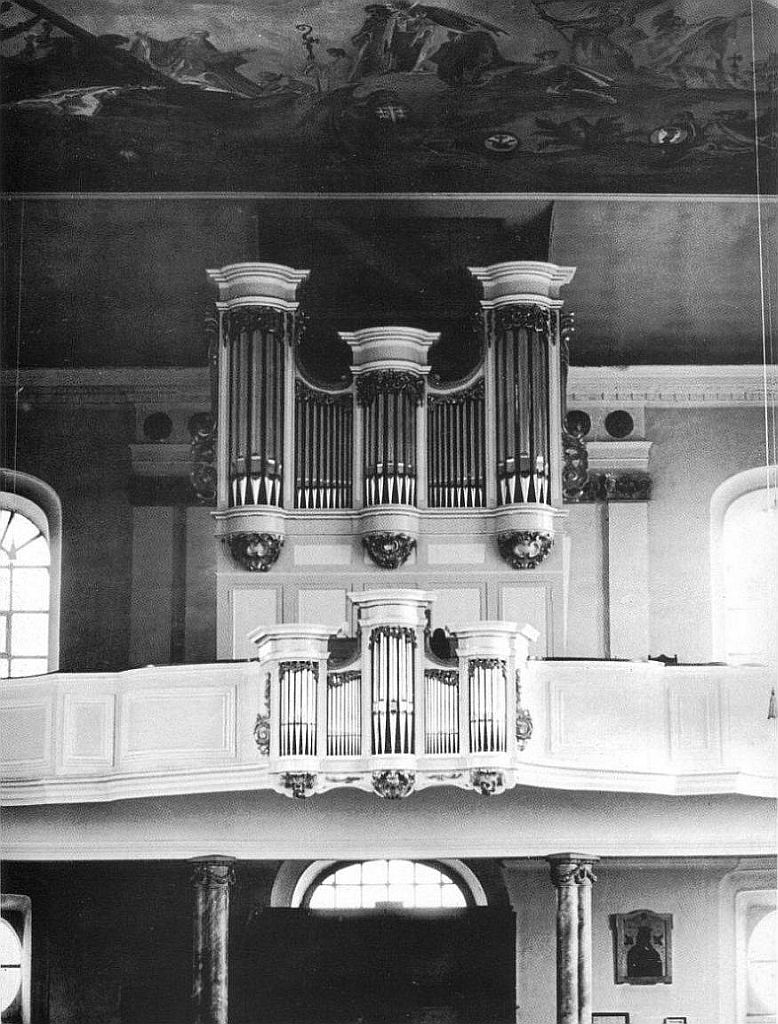Description complète d'orgue sélectionné

Source: firma Hugo Mayer
Blieskastel, Deutschland (Saarland) - Schlosskirche (Katholische Pfarrkirche Sankt Anna und Philipp)
Commune: Blieskastel
Adresse: Schloßbergstraße 47, 66440, Blieskastel
Site Web: https://www.hl-franziskus-blieskastel.de/
Description no.: 2014201.
Bâti par: Hugo Mayer Orgelbau (1972)
L'orgue comprend le parent le matériel: Organ case de 1905 de G.F. Steinmeyer und Co.
Données techniques
Composition
Hauptwerk (C-g'''): Bourdon 16' - 2018; C-f' from Subbass, Praestant 8' - 2018, Rohrflöte 8', Quintade 8', Octave 4' - 2018, Kleingedackt 4', Principalquinte 2 2/3', Superoctave 2', Mixtur 4 fach (1 1/3'), Trompete 8' - 2018.
Rückpositiv (C-g'''): Holzgedackt 8', Praestant 4' - 2018, Principal 2', Larigot 2' + 1 1/3'' - 2018, Sesquialter 2 fach (1 1/3') - 2018, Vox Humana 8' - 2018, Tremulant.
Schwellwerk (C-g'''): Holzflöte 8', Salicional 8' - 2018, Schwebung 8' (from c°) - 2018, Fugara 4' - 2018, Querflöte 4', Nazard 2 2/3', Waldflöte 2', Terz 1 3/5', Trompette Harmonique 8', Hautbois 8', Tremulant.
Pedal (C-f'): Untersatz 32' - 2018; acoustic extension, Subbass 16', Octavbass 8', Metallgedackt 8' - extension, Octave 4' - extension, Posaune 16' - 2018, Trompete 8' - extension.
Accouplements: Hauptwerk - Rückpositiv, Hauptwerk - Schwellwerk, Rückpositiv - Schwellwerk, Pedal - Hauptwerk, Pedal - Rückpositiv, Pedal - Schwellwerk.
Jouer conseils: Sezterkombinationen 2', Rollschweller 2'.

Source: firma Hugo Mayer
Blieskastel, Deutschland (Saarland) - Schlosskirche (Katholische Pfarrkirche Sankt Anna und Philipp)
Commune: Blieskastel
Adresse: Schloßbergstraße 47, 66440, Blieskastel
Site Web: https://www.hl-franziskus-blieskastel.de/
Description no.: 2014201.
Bâti par: Hugo Mayer Orgelbau (1972)
L'orgue comprend le parent le matériel: Organ case de 1905 de G.F. Steinmeyer und Co.
| Année | Facteur | Opus | Activité | 1905 | G.F. Steinmeyer und Co. | 851 | orgue neuf | 1972 | Hugo Mayer Orgelbau | orgue neuf dans buffet vieille | 2018 | Klais Orgelbau | conversion |
- The Steinmeyer company built a new organ as opus 851 for the Schlosskirche in Blieskastel in 1905. They designed an organ case in a classical baroque style. A positive was also built, but this remained empty, with non speaking prospect pipes. The Steinmeyer organ had 24 stops, two manuals and pedal and was built with pneumatic action and membrane chests.
- The interior was replaced by a new instrument in 1972 by Hugo Mayer. At this time the positive was also taken into function.
- Because of many technical problems that occured, the organ was rebuilt by Klais in 2018. They constructed a new console, a complete new action, partial new wind chests and new prosptect pipes. The stop list was slighty modified and the internal structure of the instrument was corrected. The renewed organ was dedicated on October 28, 2018. It was played by that occasion by Christian von Blohn and Matthias Leiner.
Données techniques
| Nombre de registres par manuel | |
| - Hauptwerk | 10 |
| - Rückpositiv | 6 |
| - Schwellwerk | 10 |
| - Pedal | 7 (3) |
| Nombre de jeux total | 33 |
| Transmission des clés | Mechanical |
| Transmission des jeux | Electrical |
| Sommier(s) | Slider chests |
Composition
Hauptwerk (C-g'''): Bourdon 16' - 2018; C-f' from Subbass, Praestant 8' - 2018, Rohrflöte 8', Quintade 8', Octave 4' - 2018, Kleingedackt 4', Principalquinte 2 2/3', Superoctave 2', Mixtur 4 fach (1 1/3'), Trompete 8' - 2018.
Rückpositiv (C-g'''): Holzgedackt 8', Praestant 4' - 2018, Principal 2', Larigot 2' + 1 1/3'' - 2018, Sesquialter 2 fach (1 1/3') - 2018, Vox Humana 8' - 2018, Tremulant.
Schwellwerk (C-g'''): Holzflöte 8', Salicional 8' - 2018, Schwebung 8' (from c°) - 2018, Fugara 4' - 2018, Querflöte 4', Nazard 2 2/3', Waldflöte 2', Terz 1 3/5', Trompette Harmonique 8', Hautbois 8', Tremulant.
Pedal (C-f'): Untersatz 32' - 2018; acoustic extension, Subbass 16', Octavbass 8', Metallgedackt 8' - extension, Octave 4' - extension, Posaune 16' - 2018, Trompete 8' - extension.
Accouplements: Hauptwerk - Rückpositiv, Hauptwerk - Schwellwerk, Rückpositiv - Schwellwerk, Pedal - Hauptwerk, Pedal - Rückpositiv, Pedal - Schwellwerk.
Jouer conseils: Sezterkombinationen 2', Rollschweller 2'.
| Aliquot | Composition |
| Sesquialter 2 fach (Rückpositiv) | C: 1 1/3' - 4/5'. c°: 2 2/3' - 1 3/5'. |
| Autres données des dispositions | |
|---|---|
| Autres dispositions |
|
| Références |
|
| Lièns |
https://de.wikipedia.org/wiki/Schlosskirche_(Blieskastel)#Orgel |
